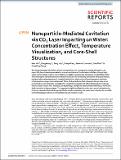| dc.contributor.author | Johnson, Steven G | |
| dc.contributor.author | Fink, Yoel | |
| dc.date.accessioned | 2020-03-25T10:43:29Z | |
| dc.date.available | 2020-03-25T10:43:29Z | |
| dc.date.issued | 2019-12 | |
| dc.identifier.issn | 2045-2322 | |
| dc.identifier.uri | https://hdl.handle.net/1721.1/124306 | |
| dc.description.abstract | By taking advantage of seeded polymer nanoparticles and strong photo energy absorption, we report CO2 laser impacting on water to produce cavitation at the air/water interface. Using a high-speed camera, three regimes (no cavitation, cavitation, and pseudo-cavitation) are identified within a broad range of nanoparticles concentration and size. The underlying correlation among cavitation, nanoparticles and temperature is revealed by the direct observation of spatiotemporal evolution of temperature using a thermal cameral. These findings indicate that nanoparticles not only act as preexisted nuclei to promote nucleation for cavitation, but also likely affect temperature to change the nucleation rate as well. Moreover, by exploiting a compound hexane/water interface, a novel core-shell cavitation is demonstrated. This approach might be utilized to attain and control cavitations by choosing nanoparticles and designing interfaces while operating at a lower laser intensity, for versatile technological applications in material science and medical surgery. | en_US |
| dc.description.sponsorship | China. National Thousand-Young-Talents Program (No. KHH2126001) | en_US |
| dc.description.sponsorship | China. National Thousand-Young-Talents Program (No. QXH2126001) | en_US |
| dc.description.sponsorship | China. National Thousand-Young-Talents Program (No. QXH2126002) | en_US |
| dc.description.sponsorship | National Natural Science Foundation of China (No. 11704077) | en_US |
| dc.description.sponsorship | China Postdoctoral Science Foundation (No. 2018T110342) | en_US |
| dc.description.sponsorship | Futan University (Shanghai, China) (startup No. JIH2126102) | en_US |
| dc.description.sponsorship | Futan University (Shanghai, China) (startup No. JIH2126023) | en_US |
| dc.description.sponsorship | National Science Foundation (U.S.). Materials Research Science and Engineering Centers (Program) (Award DMR-1419807) | en_US |
| dc.language.iso | en | |
| dc.publisher | Springer Science and Business Media LLC | en_US |
| dc.relation.isversionof | 10.1038/s41598-019-54531-1 | en_US |
| dc.rights | Creative Commons Attribution 4.0 International license | en_US |
| dc.rights.uri | https://creativecommons.org/licenses/by/4.0/ | en_US |
| dc.source | Scientific Reports | en_US |
| dc.subject | Multidisciplinary | en_US |
| dc.title | Nanoparticle-Mediated Cavitation via CO2 Laser Impacting on Water: Concentration Effect, Temperature Visualization, and Core-Shell Structures | en_US |
| dc.type | Article | en_US |
| dc.identifier.citation | Hu, Man et al. "Nanoparticle-Mediated Cavitation via CO2 Laser Impacting on Water: Concentration Effect, Temperature Visualization, and Core-Shell Structures." Scientific reports 9(2019): 18326 © 2019 The Author(s) | en_US |
| dc.contributor.department | Massachusetts Institute of Technology. Department of Materials Science and Engineering | en_US |
| dc.contributor.department | Massachusetts Institute of Technology. Department of Mathematics | en_US |
| dc.contributor.department | Massachusetts Institute of Technology. Research Laboratory of Electronics | en_US |
| dc.relation.journal | Scientific reports | en_US |
| dc.eprint.version | Final published version | en_US |
| dc.type.uri | http://purl.org/eprint/type/JournalArticle | en_US |
| eprint.status | http://purl.org/eprint/status/PeerReviewed | en_US |
| dc.date.updated | 2020-02-20T16:35:43Z | |
| dspace.date.submission | 2020-02-20T16:35:45Z | |
| mit.journal.volume | 9 | en_US |
| mit.journal.issue | 1 | en_US |
| mit.license | PUBLISHER_CC | |
| mit.metadata.status | Complete | |
